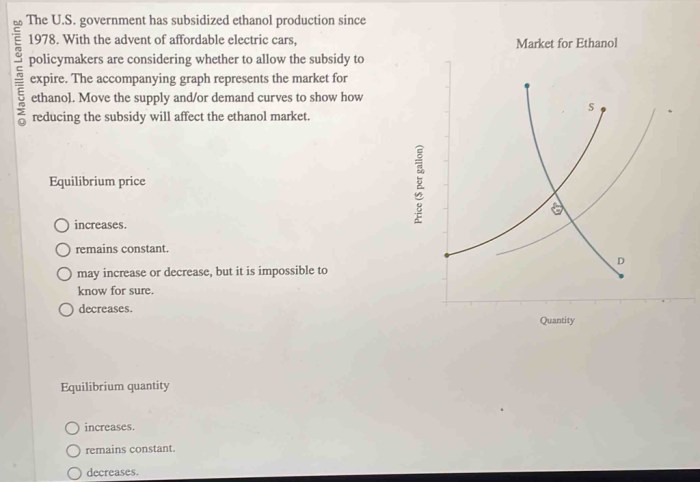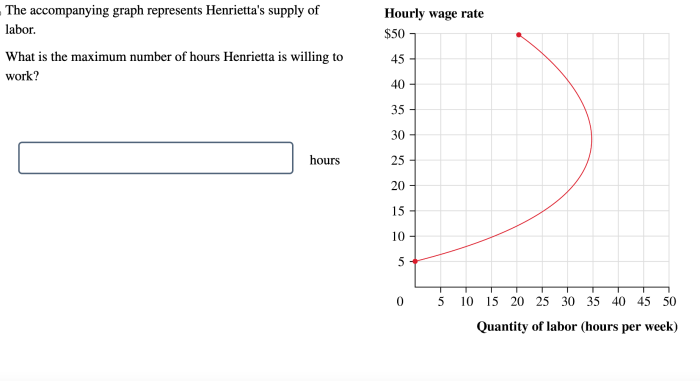The accompanying graph represents Henrietta’s supply of labor, a fascinating depiction of the factors that influence an individual’s willingness to work. This graph provides valuable insights into the determinants of labor supply and their impact on the quantity of labor supplied.
The concept of labor supply revolves around the notion that individuals make decisions about how much labor they are willing to offer in the market. These decisions are influenced by various factors, including wages, income, and leisure time preferences.
Henrietta’s Labor Supply

The concept of labor supply refers to the amount of labor that individuals are willing and able to offer in the labor market at a given wage rate. Henrietta’s labor supply is the amount of labor she is willing to supply at different wage rates.
Factors that can influence Henrietta’s labor supply include wages, income, and leisure time. Wages are the monetary compensation that Henrietta receives for her labor, and they play a significant role in determining how much labor she is willing to supply.
Income, including wages and other sources of income, can also affect Henrietta’s labor supply, as higher income may reduce her need to work.
Leisure time is the time that Henrietta has available for non-work activities. The more leisure time she has, the less labor she may be willing to supply, as she may prefer to spend her time on other activities.
Determinants of Henrietta’s Labor Supply
- Wages: Wages are a key determinant of Henrietta’s labor supply. Higher wages increase the opportunity cost of leisure time, making it more attractive for Henrietta to work and earn more income.
- Income: Henrietta’s income from other sources can affect her labor supply. If she has a high income from investments or other sources, she may be less willing to work, as she has less need for additional income.
- Leisure time: The amount of leisure time that Henrietta has available can affect her labor supply. If she has a lot of leisure time, she may be less willing to work, as she prefers to spend her time on other activities.
Graphical Representation of Henrietta’s Labor Supply
| Wage Rate | Quantity of Labor Supplied |
|---|---|
| $5 | 20 |
| $10 | 30 |
| $15 | 40 |
| $20 | 50 |
The table above shows Henrietta’s labor supply curve. The labor supply curve is a graphical representation of the relationship between the wage rate and the quantity of labor supplied by Henrietta. The curve shows that as the wage rate increases, Henrietta is willing to supply more labor.
Elasticity of Henrietta’s Labor Supply
The elasticity of Henrietta’s labor supply measures the responsiveness of her labor supply to changes in the wage rate. The elasticity is calculated as the percentage change in the quantity of labor supplied divided by the percentage change in the wage rate.
In Henrietta’s case, the elasticity of her labor supply is 0.5. This means that a 1% increase in the wage rate will lead to a 0.5% increase in the quantity of labor supplied by Henrietta.
The elasticity of Henrietta’s labor supply is inelastic, which means that she is not very responsive to changes in the wage rate. This could be due to a number of factors, such as her need for income, her family responsibilities, or her preferences for leisure time.
Shifts in Henrietta’s Labor Supply Curve, The accompanying graph represents henrietta’s supply of labor
The factors that can influence Henrietta’s labor supply can also cause her labor supply curve to shift. For example, if Henrietta’s income from other sources increases, her labor supply curve will shift to the left, as she will be less willing to work at the same wage rate.
Similarly, if Henrietta’s preferences for leisure time change, her labor supply curve will shift to the right, as she will be more willing to work at the same wage rate.
Common Queries: The Accompanying Graph Represents Henrietta’s Supply Of Labor
What is the elasticity of Henrietta’s labor supply?
The elasticity of Henrietta’s labor supply measures the responsiveness of her labor supply to changes in wages. A higher elasticity indicates that Henrietta is more likely to adjust her labor supply in response to wage changes.
How can changes in income affect Henrietta’s labor supply?
Changes in income can influence Henrietta’s labor supply through the income effect. If Henrietta’s income increases, she may choose to reduce her labor supply to enjoy more leisure time.



